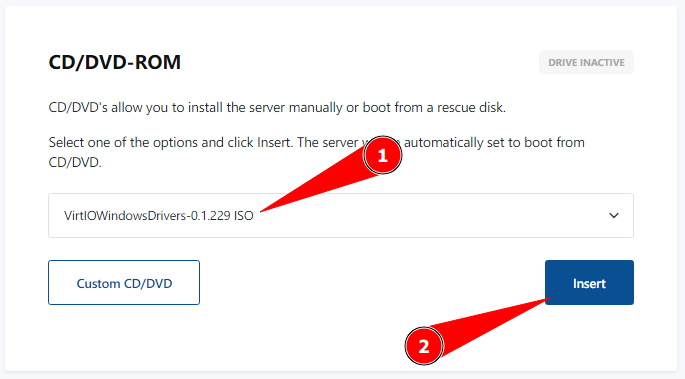If you use custom ISO installation method, chances are, the OS will have missing drivers after installation (especially network interface driver on Windows platform).
Since custom ISO installation method has been mostly used for installation of various editions of Windows, in this article, the descriptions are based on missing drivers on Windows.
For checking the drivers and installing the missing ones, do as decried bellow.
1. After logging in into Windows (usually via VNC), press Ctrl + R (or click on the Start menu) and type devmgmt.msc to open the Device Manager.

2. In the Device Manager window, you can see the missing drivers (if any).

3. In order to install the missing drivers, you need to mount an ISO which has the necessary drivers in it. So go to the Control Panel for the management of your server which is available at manage.webhorizon.net and after clicking on the Media button on the top, click on the Preset CD/DVD button so that you can use the ISOs that are already provided by us.

4. From the list of available ISOs, choose VirtIOWindowsDrivers and then click on the Insert button.

5. Now you can head back to the VNC window and in the Windows Explorer, you can see and access the mounted ISO which contains all of the drivers.
Note: Take note of the drive letter that Windows has assigned to the mounted ISO drive (in this case, D)

6. We now open the Device Manager window once again to install the missing drivers.
Right click on the missing driver icon and click on Update driver

7. In the opened window, click on the Browse my computer for drivers.

8. In the next page of the window, type the drive letter that Windows has assigned to the mounted ISO (step 5) and also make sure that you have check the Include subfolders check box and then click on the Next button.

9. Windows will check various folders and subfolders in the mounted ISO and install the appropriate driver.

10. You should do steps 6 to 9 for all the missing drivers.
11. Now that you have installed all the missing drivers (including the network interface driver), you need to manually enter the IP address that has been assigned to your server.
For doing this, click on the Start menu and type ncpa.cpl so that the Network Connections window appears.


12. Double click on the network adapter icon as shown bellow, click on Properties, in the newly opened window double click on Internet Protocol Version 4 (TCP/IPv4) and finally choose Use the following IP addressee.

13. At this stage you need the IPv4, Subnet, Gateway and DNS addresses that are assigned to your server. You can find those information in the Network section of Control Panel for the management of your server

12. Enter all the required IP addresses and finally click OK.

13. If everything have been done properly, you will be connected to the network and can access your server via other means such as RDP and/or SSH too.
